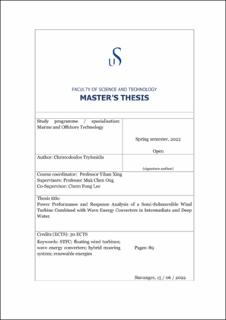| dc.description.abstract | Renewable energies are the forefront against environmental pollution and the leading technology in sustainable energy sources. Power produced by wind energy is a well established technology. There is a lot of space for expansion though, especially at offshore environment. Floating wind turbines can take advantage of the abundant wind energy available far out at the oceans. Increasing the power production of such structures and ensuring the efficient and safe position keeping of them in every depth is crucial. Two concepts that aim to tackle down these two issues are proposed. A combination of wind and wave energy converters and an intermediate water depth mooring arrangement. The installation of wave energy converters (WECs) at the floating wind turbine base will reduce the levelized cost of energy (LCoE). The use of the same power cables and mooring arrangement to deploy the WECs can prove beneficial financially wise. Furthermore, it can act as a boost to the development of wave energy in general. The transient depth between shallow and deep is a challenging field for the traditional mooring arrangements. A cost effective solution will help the deployment of floating wind turbines in this intermediate water depth fields.
A novel concept of combining a floating wind turbine with WECs is proposed. A semi submersible floater is used to support a 5MW wind turbine. Three flap typed WECs are deployed on the pontoons of the floater. A two-point type absorber called Torus is installed at the central column. The proposed concept is named STFC. A thorough analysis of the natural periods, regular and irregular wave tests is performed to evaluate the effect of the WECs to the floater’s behavior. Small to no effect is observed across all degrees of freedom except the reduction in pitch period due to increased hydrostatic stiffness. The irregular wave tests indicate that the absorbed power amplitude operator (RAO) of Torus has a wider excitation range than the flaps. The floater heave RAO is affected by the addition of Torus and the floater surge and pitch RAOs are affected by the additions of flaps. Irregular waves tests are carried out to evaluate the influence of the added WECs to the motions of the combined concept and the total power performance. The results indicate that the WECs have little to no effect to the motions of the structure except the expected reduction in pitch motions. This is preliminary indication that no changes should be made to the mooring due to the addition of WECs. The wind turbine power performance is not affected by the addition of WECs. There is small reduction in pitch standard deviation though, in loading condition EC3 that leads to slightly better wind quality. The Torus performance is satisfactory as it accounts for 9% of the total STFC power production. The total three flaps account only for 14% of the Torus power production thus their power performance is not satisfactory. The flaps rotation is out of phase with the wave excitation force so there is room for improvement if active damping and stiffness control is added.
Following, the STFC is moved to intermediate water depth z = -50m and a new hybrid mooring design is proposed. A brief explanation of the intermediate water mooring challenges is given and the basic design criteria are established. A step to step designing process is presented. The combination of studded chain, buoys, and clump weights is proposed. The name of the concept is CCCB. A restoring force test is carried out and the linearity of the restoring force response is verified. Irregular wave tests are carried out and the data indicate that the new mooring design is a feasible design. The maximum floater offset is restrained to 14% of the water depth. The pretension of the mooring system proves to be a significant factor for the total performance of the mooring arrangement. The maximum mooring line tension is kept within safe limits throughout the whole offset range. CCCB is compared with similar concepts and proves itself stiffer mainly because of its increased pretension. Points of interest are defined across the mooring line and spectra analysis is performed to evaluate the distribution of response frequencies across the chain length. The role of buoys as dampers of motions is established. CCCB utilization factor indicates that this mooring design can be used also in larger structures and there is room for cost reduction measures. | |
